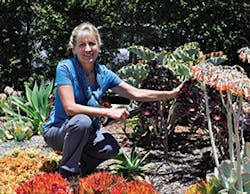For JoEllen Jacoby, less is more. Each day, Jacoby, a licensed landscape architect and the supervising landscape conservation designer for San Diego’s Water Conservation Program, endeavors to “affect change in the way we look at water use in our landscape, and to teach people to relish and respect the importance of water in their life.” Her focus: the city’s 280,000 customers. Helping her in that task are three field representatives, a supervising field representative, three irrigation specialists, a public information clerk, a management analyst, and an intern.
The small team has had a large impact in rebate and survey programs and has won awards spotlighting their success: a 2012 Coastal Champion Award in the “Water Wise” category for a landscape rebate program, a 2011 EARTH Award from San Diego Earthworks, and a 2006 Flex Your Power Award for education and leadership in energy efficiency. Their expertise is shared with others as presenters at the WaterSmart Innovations Conference on their Commercial Landscape Survey Program (Data Mining Five Years of Commercial Landscape Audits shows the Pros and Cons of the Audit Program), Water Use Restrictions During Drought (San Diego and Los Angeles Compare the Success of Water Use Restrictions), and Outreach Efforts (San Diegans Waste No Water). Jacoby serves on the Irrigation Association’s Smart Water Applications Technology (SWAT) promotion subcommittee.
How She Spends Her Days
On an average day, Jacoby oversees a myriad of staff activities: two conduct residential surveys at customers’ homes, two are in the field assisting customers with landscape rebates, one works on a commercial landscape survey, and one responds to water waste complaints. Jacoby and four staff members are certified landscape irrigation auditors who often field questions about irrigation design and schedules. Jacoby also oversees turf conversion inquiries, promotes programs and develops new ones, and works on policy. Her group hosts a landscape contest in the spring. Currently, they’re promoting a series of California Friendly Plant Classes. They’ve recently instituted a rain barrel rebate.
“We always need to get the word out about our services and rebates,” notes Jacoby. The website and promotional materials are constantly being modified to accurately address the programs. “I often collaborate with members of other agencies and organizations on programs such as our state-funded integrated grant program [Proposition 84 IRWMP)],” she says. In the rest of her time, she’s presenting to organizations, schools, and other groups about the need to rethink landscape water needs.
What Attracted Her to the Water Efficiency Field
Jacoby has a Bachelor’s degree in government and a Master’s degree in landscape architecture. After arriving in San Diego as a young landscape architect, one of the first professional presentations Jacoby attended dealt with southern California’s water scarcity. “I soon realized that San Diego’s attractive climate came with a price, and that the landscape designs we were taught to create did not reflect the true environment or character of the region,” she says. She learned more about irrigation and participated in the early formation of the San Diego Xeriscape Association. She joined the city’s water department in 1991 and developed the format of the first residential survey program.
What She Likes About Her Job
There are two aspects of her job that Jacoby enjoys. One is teaching people about the area’s water supply: where it comes from and how much is used on traditional landscapes. The other is participating in the development of policies that create positive future impacts. Jacoby worked on the local language for the AB 1881 Model Landscape Ordinance, Municipal Code for the Emergency Water Regulations and is currently working on a proposed Large Landscape Water Budget ordinance.
Help Us Highlight Industry Superstars
Water Efficiency is accepting Reader Profile nominees. E-mail us for more information, at [email protected].


